The Department for Physics of Planetary Systems
History
In May 1967 the department for Physics of the Moon and Planets; was created, it was led by Dr.Sci. I. K. Koval'.
In 1984, the department was renamed to the Department for Physics of the solar system bodies. In 1975-1999 the Department was headed by Dr.Sci., Prof. O. V. Morozhenko, since 2000 it is headed by Dr.Sci. A. P. Vidmachenko.
In 1984 the Laboratory for the Theory of Radiative Transfer was created and functioned till 2000. Dr.Sci., Professor E. G. Yanovitskij was the head of the Laboratory.
In 2006 the Laboratory for Specrtoplarimetric monitoring of celestial bodies was created and functioned till 2012. Dr. O. E. Rozenbush was the head of the Laboratory.
In 2013 the department was renamed to the Department for Physics of planetary systems. Department is headed by Dr.Sci., Prof. A. P. Vidmachenko.
Since 2009 the Department includes the Laboratory of Atmospheric Optics (Head of Laboratory - Dr. M.G. Sosonkin).
In 2009 - 2014 the Department includes the Laboratory for Atmospheric Optics (the head was Ph.D. M.G. Sosonkin, and from 2013 is Dr.Sci., G. P. Milinevsky).
The department is responsible for the operation of technical systems based on the following telescopes:
- Telescope AZT-2 (D = 70 cm) was mounted in 1959.
- Kyiv Internet telescope КІТ - based telescope Celestron 14" – in 2005.
- Telescope Celestron 14" – in 2012
Main areas of research:
Collaborators of our Department research Solar system planets and their satellites, planetary systems around stars of Milky Way and stars having disc structures.
Experimental explorations are carried out by the methods of optical spectrometry, photometry and polarimetry.
Observations are realized on the base of three telescopes of our Department: AZT-2 with apertureof 70 cm (optical system of Newton/Cassegrain)[link] and two telescopes Celestron-14″ (optical system of Cassegrain)located at MAO NASU[link]and Lisnyky Observational Station of the Kyiv Taras Shevchenko University[ KIT ].
Also much attention is given to the theoretical calculations in the fields of task solving theradiative transfer theory and process modeling in planetary atmospheres, mathematics modeling of spectral energy distributions in the disc structures around stars and substars, and light scattering processes by atmospherelessSolar system bodies.
In 2012 the working group"Observations at small telescopes of exoplanets, Solar system bodies and other objects" was created at MAO NASU. Researches of chromospherical activity of stars having exoplanets and transit systems are carried out in the frames of thistopic. Also some collaborators take part in the program of exoplanet search in close eclipse binaries "DWARF project".
Main scientific fields:
- Researches of Solar system bodies, variations in planetary atmospheres and on their satellites, remote methods of researches the vertical structures of planetary atmospheres.
- Development of analytical and numerical methods of calculations the radiative transfer in planetary atmospheres and radiation reflectedby rough surfaces, and processes of electromagnetic radiative scattering by environments consisting of morphologically composite groups of particles and by atmosphereless surfaces.
- Researches of planetary systems around Milky Way stars and stars having disc structures by the methods of spectrometry, photometry and polarimetry observations and numerical modeling.
- Numerical modeling of spectral energy distributions in disc structures around stars and substars.
- Spectroscopy of Solar system bodies, their satellites, stars having exoplanets and stars having disc structures.
- Astronomy instrumentation.
Achievements:
- The theory of radiative transfer in inhomogeneous atmospheres was developed ( Yanovytskij E.G. )
- An inventor's certificate for an achromatic phase plate was received( V.A.Kucherov , V.S.Samoylov , O.I.Buhayenko )
- The world's electro-polarimeter for photons counting was created (O.I.Buhayenko, L.A. Bugaenko)
- Dual-channel spectropolarimeter "Planetary Patrol” was created.
- It was designed laboratory Stokes polarimeter to measure radiation reflected by a rough surface
- Presence of the ammonia gas in the atmosphere of Saturn and oriented particles in the upper layers of Saturn's atmosphere was proved ( O. I. Buhayenko , O. V. Morozhenko )
- The presence of oriented particles in the upper layers of the equatorial regions of Saturn was established(O. I. Buhayenko, A. V. Morozhenko).
- Periodic changes in Jupiter's integral brightness and seasonal restructurization of Jupiter's and Saturn's atmospheres were found (A. P. Vidmachenko).
- Asymmetry of Venus cloud layers was registered (Yanovytskii E. G., Klimenko V. M.)
- Tides in the atmosphere of Neptune, due by the satellite Triton was found (A. V. Morozhenko, M. S. Dement'ev)
- Calculations shown that the vertical movement of gas and aerosol in the atmosphere of giant planets with velocity w = (0.1-0.5) m/s determines the capacity of visible clouds and therefore affects their brightness characteristics (A. P. Vidmachenko).
- It was proposed and implemented the method of observation and data treatment, that allow to register oscillations of hydrogen-helium atmospheres of Jupiter (T = 103 and 142 min.) and Saturn (T=137 and 179 min.) (Vidmachenko A. P.)
- An explanation of the unique behavior of the brightness and polarization, observed for a number of bodies in the solar system, that have no atmosphere was proposed. To explain the opposition effect formation in the brightness of some of the solar system bodies the effect of coherent backscattering was used (M. I. Mishchenko, J. M. Dluhach)
- Numerically precise solution of Maxwell's equations has confirmed the possibility of photometric and polarization opposition effects in substances with enough high density packing of particles, that can explain the observations, obtained for a number of solar system bodies (such as asteroids Nisa 44 and 64 Angelina, Satellite Europe, rings of Saturn) without of atmosphere and with high albedo (Zh. M. Dluhach).
- Exoplanet WASP-10C was discovered by an international team of researchers with fellow department (V. M. Krushevskaia).
- New effects were discovered and some physical characteristics of aerosols in the atmospheres of Mars, Jupiter and Saturn were identified at first according to the long-term observations of the solar system bodies in many observatories ( Morozhenko O. V.)
- Scientists of the department involved in the processing of materials derived from spacecraft "Mars-3" and "Mars-5".
- Compact board layout space polarimeter UFP for the study of the earth's stratospheric aerosol was created and two patents for the invention of the statistical narrow band filter polarimeter and airborne static polarimeter was obtained (Nevodovskiy P. V., Herayimchuk M. D., Nevodovskiy E. P.)
- Thanks to the unique devices manufactured in the department:
- The brightness opposition effect of Mars was discovered;
- the existence of ammonia gas in the atmosphere of Saturn and oriented particles in the upper atmosphere of Saturn had been proved;
- periodic changes in the brightness of the northern and southern hemispheres of Jupiter and Saturn was revealed. It was discovered circular polarization of light Halley's Comet;
- the impact of the satellite Triton power absorption bands of methane on Neptune was discovered;
- the opposition effect of the polarization of light reflected Galilean satellites of Jupiter was discovered;
- Global horizontal heterogeneity regular layer clouds of Venus was discovered, etc.
Devices made at the department:
- Automatic photopolarimeter;
- Electrophotometer for measuring of weak fluxes;
- Astronomical spectropolarimeter ("Planetary patrol");
- Fourier spectrometer;
- Stokes-polarimeter;
- Digital panoramic polarimeter.
The theory and technology of multicomponent achromatic waveplates manufacturing were developed at the Department.
- In 1995 E. G. Yanovitskij published a monograph "Light Scattering in Inhomogeneous Atmospheres" (translated into English by Springer in 1997) where the fundamentals of the analytical theory of radiative transfer in inhomogeneous flat atmospheres are expounded in details for the first time.
- In 2004 O. V. Morozhenko published a monograph: "Methods and results of remote sensing of planetary atmospheres" (Kyiv: Naukova Dumka, 2004, 648 p.). The book covers the basic concepts that characterize the field options diffusely reflected radiation of the planets and the gas-aerosol environment of planetary atmospheres. Peculiarities of light scattering by particles of different nature and shape of the formation of molecular absorption bands in planetary atmospheres; the impact of the Earth's atmosphere on the characteristics of the light streams parameters in terms of their passage through the atmosphere; spectrophotometric methods of spectropolarimetric observations and their reduction, in that by including the effect of the earth's atmosphere; methods for the physical characteristics determination of planetary atmospheres. The basic results of the study of the optical characteristics of diffusely reflected radiation field and physical characteristics, especially the aerosol component, the atmospheres of Venus, Mars, Jupiter, Saturn, Uranus, Neptune, moons Titan and Triton. We discuss some of the problems of global climate change and ozone layer of the Earth.
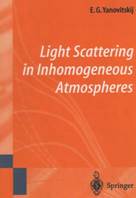 |
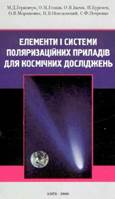 |
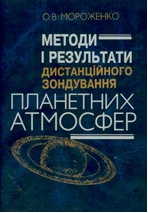 |
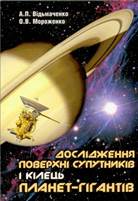 |
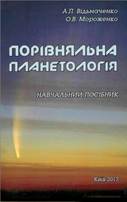 |
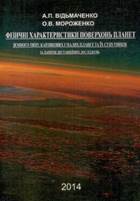 |
- In 2009 a monograph (in Ukrainian): M. D. Herayimchuk, O. N. Genkin, A. Ivakhiv, J. P. Kurenov, A. V. Morozhenko, P. V.Nevodovskyy. S. F.Petrenko. "Elements of polarization and instruments for space research" (Kyiv: Publishing House "ECMO." 2009. 178 p.) was published.
- In 2012 a monograph (in Ukrainian): Vidmachenko A. P., Morozhenko O. V. "Investigation of surface satellites and rings of giant planets" (Kyiv: DIA. - 2012. - 255 p.) was published. The book presents the main results of the study of the optical characteristics of diffusely reflected radiation and physical characteristics of the surface of the satellites of the giant planets and their rings. The publication is intended for teachers of higher educational institutions, students and professionals who specialize in experimental astrophysics and physics of the solar system surfaces.
- In 2013 a textbook on Planetology (in Ukrainian): Vidmachenko A. P., Morozhenko O. "Comparative Planetology. Textbook." (Kyiv: DIA. 2013. - 552 p.) was published. Where are presented the main characteristics of diffusely reflected radiation, interaction of light with the surface, separate particle, a brief theory of molecular spectra of individual molecules, considered spectral line and model of the absorption band, showing the changes in Stokes parameters due to multiple scattering and polarization properties are diffusely reflected radiation by rough surfaces and the formation of the thermal regime of the solar system bodies; the basic methods of optical properties of the solar system bodies with spectral, photometric and polarimetric devices, described observational methods etc.; the results of remote study of solar system bodies (large (classical) planets: Mercury, Venus, Earth, Mars, Jupiter, Saturn, Uranus and Neptune, dwarf and small planets and their satellites, rings, comets) and characteristics of exoplanets. The publication is intended for teachers of higher educational institutions, students and professionals who specialize in experimental astrophysics and physics of the solar system bodies.
- In 2014, a monograph (in Ukrainian): Vidmachenko A. P., Morozhenko O. V. "Physical characteristics of the surface Earth-like planets, dwarf and small planets and their satellites according to distance studies" (Kyiv: Publisher "Profi." - 2014. - 388 p.) was published. The book deals with the history of research and cosmogony of the solar system, the current state of planetary cosmogony, the formation of planets and their satellites, especially the internal structure of Earth-like planets and satellites, the magnetic fields of the terrestrial planets, satellites and asteroids, the general question of forming diffusely reflected rough surface radiation, parameters of the reflected radiation field (photometric, polarization and thermal properties), radar observations. The basic results of the study of the Moon, Earth-like planets ( Mars, Mercury, Venus), dwarf and small (asteroids) planets. The publication is intended for teachers of higher educational institutions, students and professionals who specialize in physical research methods of experimental physics and the physics of the solar system bodies.
MAIN RESULTS OBTAINED BY THE DEPARTMENT TEAM:
THE STAFF OF THE DEPARTMENT:
| Yakiv Pavlenko | Head of the Department, Dr.Sci. | yp(at)mao.kiev.ua |
| Anatoliy Vid'machenko | Dr.Sci. Professor | vida(at)mao.kiev.ua |
| Yurii Lyubchyk | Ph.D. | lyu(at)mao.kiev.ua |
| Valentina Sheminova | Dr.Sci. | shem(at)mao.kiev.ua |
| Alexander Delets | ||
| Victoriya Krushevska | Ph.D. | vkrush(at)mao.kiev.ua |
| Juliana Kuznetzova | juliana(at)mao.kiev.ua | |
| Pjotr Nevodowskij | Ph.D. | nevod(at)mao.kiev.ua |
| Alexandr Ovsak | Ph.D. | |
| Olexiy Ivaniuk | oi(at)mao.kiev.ua | |
| Bogdan Kaminsky | Ph.D. | bogdan(at)mao.kiev.ua |
| Olga Zakhozhay | Ph.D. |



 COORDINATES
COORDINATES